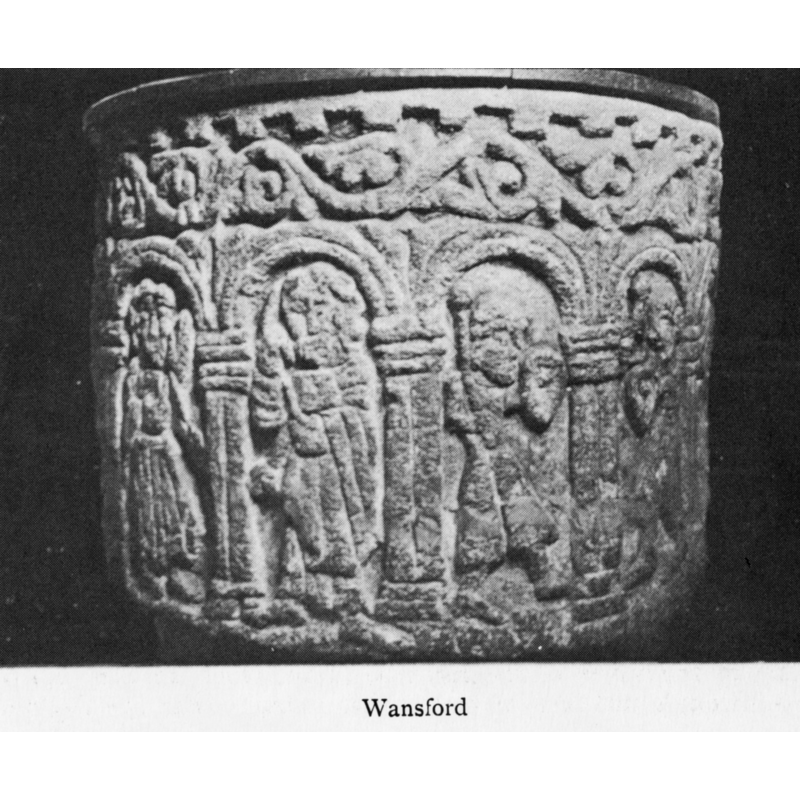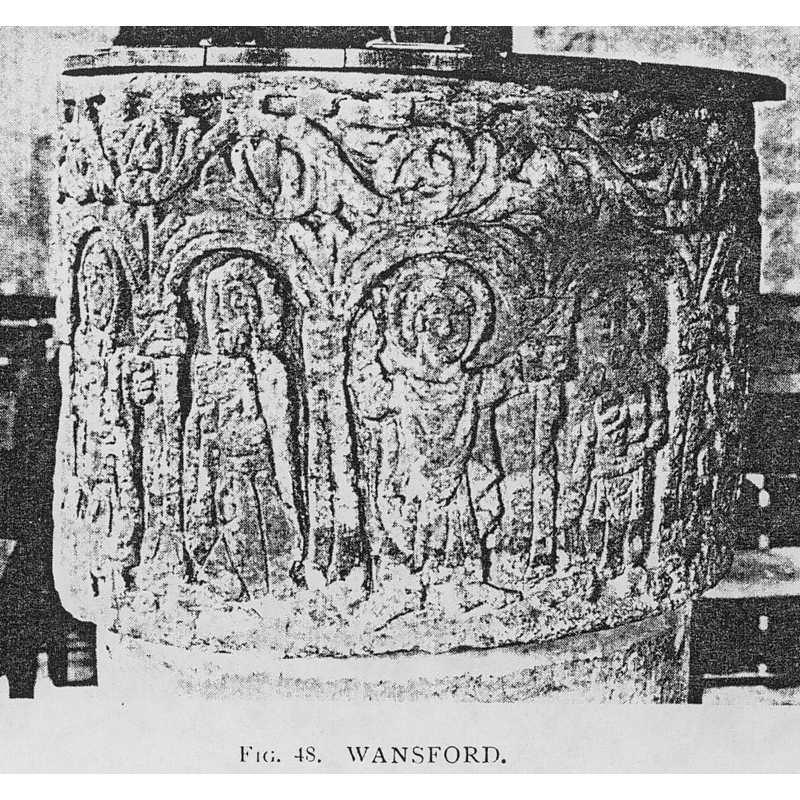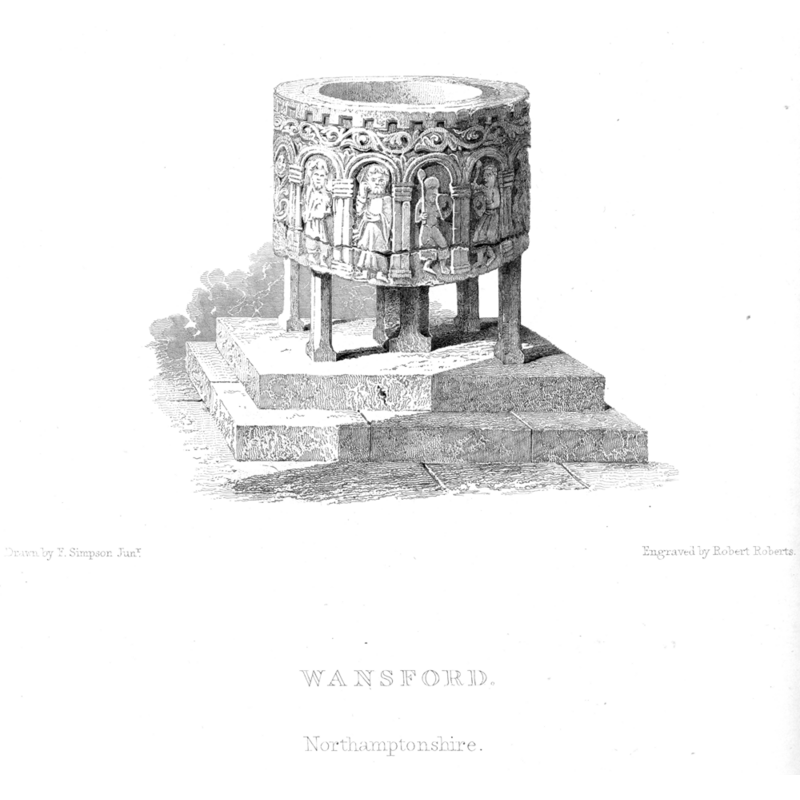Wansford / Wandsford / WalmsfordSibberton Lodge]
![Main image for Wansford / Wandsford / WalmsfordSibberton Lodge]](/static-50478a99ec6f36a15d6234548c59f63da52304e5/compressed/WAN9802305_compressed.png)
Image copyright © Baptisteria Sacra Index, 2023
Results: 40 records
B01: human figure - warrior - 2 - fighting
B02: New Testament - public life of Christ - Christ pointing at second person
B04: Christ - pointing to a person
B05: symbol - tree - Tree of life
B06: New Testament - public life of Christ - baptism of Christ - in the Jordan - Manus Dei - dove?
B07: human figure - gesturing
B08: human figure - gesturing
design element - architectural - arcade - round arches
design element - motifs - foliage
view of basin
view of basin
view of basin - detail
view of basin - detail
view of basin - detail
view of basin - detail
view of basin - detail
view of basin - detail
view of basin - detail
view of basin - detail
view of basin - detail
view of basin - detail
view of basin - detail
view of basin - detail
view of basin - detail
view of basin - detail
view of basin - detail
view of basin - detail
view of basin - detail
view of basin - detail
view of basin - detail
view of basin - detail
view of church exterior
view of font
view of font
view of font
view of font
view of font
view of font - east side
view of font - west side
INFORMATION
FontID: 00136WAN
Object Type: Baptismal Font1
Church/Chapel: Parish Church of St. Mary the Virgin [orig. from an unknown church]
Church Patron Saints: St. Mary the Virgin
Church Location: Church End, Wansford Rd, Wansford PE8 6JP, UK
Country Name: England
Location: Cambridgeshire, East
Directions to Site: Located on the B671, just S of the A47, about 15 km W of Peterborough
Ecclesiastic Region: Diocese of Peterborough
Historical Region: formerly Huntingdonshire and Northamptonshire
Font Location in Church: Inside the church, in the W end of the nave [cf. Simpson's notes in Font notes area for earlier placements]
Date: ca. 1120?
Century and Period: 12th century [basin only], Medieval [composite]
Font Notes:
Click to view
No individual entry found for Wansford in the Domesday survey. Gough (1792) lists this font ["Walmsford in Northamptonshire"] as a lead font of "high antiquity" together with those at Brookland, Dorchester and Wareham [NB: the Walmsford or, in current spelling, Wansford font is ancient but it is made of stone, not lead [cf. Simpson's correction below]]. Described and illustrated with an engraving by J. Basire in Repton (1812) [NB: the name is spelled 'Wandsford'] with a five-support base; Repton notes that "the lower part of the font at Wandsford is modern". Also in Simpson (1828), who states that, most likely, this is the font listed as "the leaden Font at Walmsford" in Gough's Archaeol. (vol. x, p. 187), correcting Gough's description from lead to Barnack stone [NB: the spelling WALMSFORD appears in early English and Latin sources]; Simpson describes the scroll motif on the sides as typical of Late-Norman and Early-English work. Of the six figures that occupy six of the eight arches, Simpson identifies "two figures to the left are possibly priests; the two next evidently combatants; of the remaining two [...] one is a female the other a male, the latter mutilated." About the location of the font he comments that it "formerly stood immediately opposite the south door [which is the only entrance to the church] but it is now placed in the north wall of the church, about two feet from the ground, so that half only of it is seen." [Simpson reports having the font moved at the time to help him complete his sketch of it]. Noted and illustrated in Britton's Dictionary of 1838 with suggested date in the middle of the 12th century. Bloxham (1859) uses the name Walmsford and the wrong identification of the material as lead, probably after Gough [cf. supra]. Listed as a "leaden font" in Cox (1875). Illustrated in Corblet (1881-1882), still showing the five-support base. Lethaby (1893), too, includes this font in his chapter on lead fonts. Described and illustrated in Bond (1908) as a cylindrical Norman font ornamented with an arcade of round arches around the basin; the thirteen niches occupy most of the sides; ten of the arches contain figures: some are priests, some laymen; under the rim a crenellated edge and a band of foliage just above the arches. Described and illustrated in Tyrrell-Green (1928). Noted in Pevsner (1968): "Font. Circular, Norman. Primitively carved figures under arches. A border of leaf-trail above. The figures include a Baptism, two Knights fighting, two other groups in communication. Zarnecki supports c.1120 as the date. Described in Drake (2002). Described and illustrated in the CRSBI (2008) with an itemised list of the figures and motifs; the entry identifies the lower part of the base as a re-used early baptismal font, and adds a note on the general style of the carving: "The figures are stocky with overlarge heads and hands. Drapery is depicted by parallel grooves. Faces have round bulging eyes and cheeks, and hair is often depicted as a series of pellets. In this they resemble contemporary coin portraits." Listed and illustrated in The Digital Atlas of England [www.viewbuildings.com] with date ca. 1120. On-site notes: on the south side two niches depict two men fighting with clubs and shields, the next niche (to the right) has a vegetation motif, followed by Christ pointing at a second figure; this scene is more or less replicated in the next two niches; the next niche contains a Tree-of-life motif, followed by two more niches which show John the Baptist baptizing Christ; then there is a niche with an acanthus motif, followed by another two niches which show two figures making gestures (?). The inner basin well is lead-lined and has a centre drainage hole. The base is modern. The bowl was found in a local village/hamlet called Sibberton Lodge, parish of Thornhaugh, which had been destroyed by the plague; the basin had been used there as a water trough for cattle. The basin lower part is quite irregular, probably the original shape.
COORDINATES
Church Latitude & Longitude Decimal: 52.580213, -0.417736
Church Latitude & Longitude DMS: 52° 34′ 48.77″ N, 0° 25′ 3.85″ W
UTM: 30U 674957 5828706
MEDIUM AND MEASUREMENTS
Material: stone, Barnack stone?
Font Shape: cylindrical (mounted)
Basin Interior Shape: round
Basin Exterior Shape: round
Drainage Notes: lead lining
Rim Thickness: 11-13 cm
Diameter (inside rim): 52 cm
Diameter (includes rim): 76-78 cm
Basin Depth: 35 cm
Basin Total Height: 50-56 cm
Height of Base: 45 cm
Font Height (less Plinth): 101 cm
Font Height (with Plinth): (plinth is 15 cm) 116 cm
Notes on Measurements: BSI on-site [NB: the measurements given in the CRSBI entry fit roughly with these, but do not account for the variations of the irregular basin]
LID INFORMATION
Date: modern
Material: wood
REFERENCES
Bloxam, Matthew Holbeche, The Principles of Gothic ecclesiastical architecture, with an explanation of technical terms […], London: W. Kent, 1859
Bond, Francis, Fonts and Font Covers, London: Waterstone, 1985 c1908
Britton, John, A Dictionary of the Architecture and Archaeology of the Middle Ages, including […], London: Longman, Orne, Brown, Green, and Longmann, Paternoster Row, and the Author, Burton Street, 1838
Clapham, Alfred William, English Romanesque Architecture after the Conquest, Oxford: Clarendon Press, 1934
Corblet, Jules, Histoire dogmatique, liturgique et archéologique du sacrement de baptême, Paris: V. Palme, 1881-1882
Corpus of Romanesque Sculpture in Britain and Ireland, The Corpus of Romanesque Sculpture in Britain and Ireland, The Corpus of Romanesque Sculpture in Britain and Ireland. Accessed: 2005-02-27 00:00:00. URL: http://www.crsbi.ac.uk.
Cox, John Charles, 1875-1877
Drake, Colin Stuart, The Romanesque Fonts of Northern Europe and Scandinavia, Woodbridge, Suffolk: Boydell Press, 2002
Gough, Richard, "Description of the old font in the Church of East Meon, Hampshire, 1789: with some observations on fonts", X, Archaeologia, 1792, pp. 183-209; p. 187
Kroesen, Justin E.A., The Interior of the medieval village church = Het middeleeuwse Dorpskerkinterieur, Leuven: Uitgeverij Peeters, 2004
Lethaby, William Richard, Leadwork, old and ornamental, and for the most part English [...] with illustrations, London; New York: Macmillan & co., 1893
Pevsner, Nikolaus, Bedfordshire and the County of Huntingdon and Peterborough, Harmondsworth: Penguin, 1968
Poole, George Ayliffe, The Appropriate Character of Church Architecture, Leeds; London: T.W. Green; Rivington, Burns, and Houlston and Stoneman, 1842
Repton, John Adey, "Specimens of Fonts, collected from different Churches, by John Adey Repton, Esq. F.A.S. In a Letter addressed to Craven Ord, Esq. F.R.S. and F.A.S.V.P., read 12th March, 1807", XVI, Archaeologia, 1812, pp. 335-337 and pl. XXXVII-XLV; p. 335 and pl. XXXVII fig. 1
Simpson, Francis, A series of ancient baptismal fonts: chronologically arranged, drwan by F. Simpson, Jun., engraved by R. Roberts, London: Septimus Prowett, 1828
Tyrrell-Green, E., Baptismal Fonts Classified and Illustrated, London: Society for Promoting Christian Knowledge: The Macmillan Co., 1928








